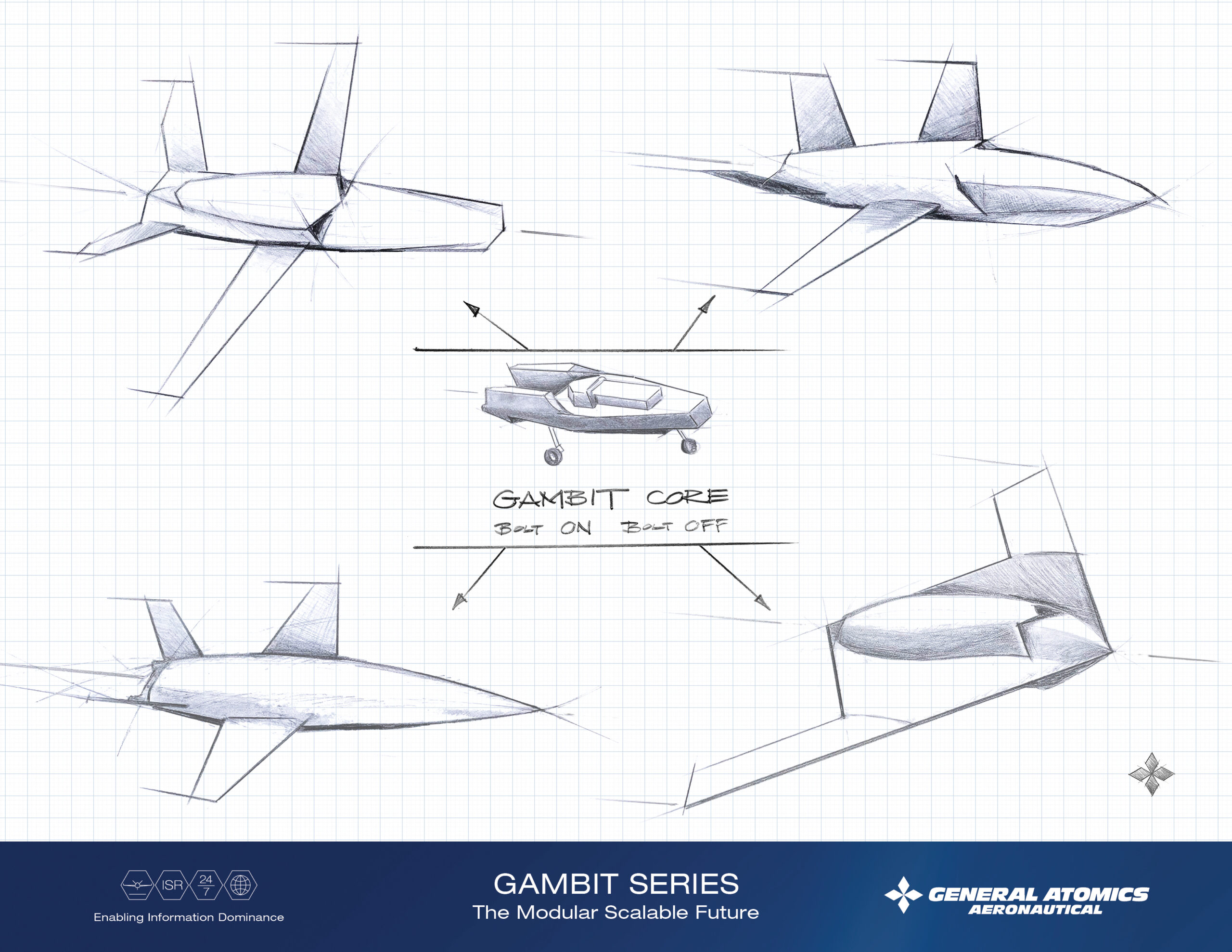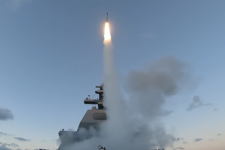
Photo Courtesy of General Atomics Aeronautical
The U.S. Air Force boasts the finest combat aircraft and pilots in the world, but even they are going to need help preserving air dominance in the coming decades.
Even Hollywood is reading the writing on the wall. Recall the speech by fictional Rear Adm. Chester “Hammer” Cain—played by actor Ed Harris, the “Drone Ranger” —in this year’s blockbuster “Top Gun: Maverick”:
“These planes you’ve been testing, Captain? One day, sooner or later, they won’t need pilots at all. Pilots that need to sleep, eat, take a nap. Pilots that disobey orders. All you did was buy some time for those men out there. The future is coming, and you’re not in it. The end is inevitable, Maverick. Your kind is headed for extinction.”
Perhaps that will be the case. Perhaps not. Most experts agree that a mix of manned and unmanned aircraft — keeping human pilots and support operators in the loop while adding more autonomy, artificial intelligence (AI), and machine learning — is our near-term future.
There’s no question that the work of air superiority is getting more difficult.
Hostile stealth fighters are proliferating. New-generation integrated air defense systems are improving their ability to detect American and allied aircraft. Sophisticated adversaries want to push the joint force ever farther from contested territory and sharpen their ability to deny it if entered. All this challenges the Air Force, its sibling services, and their international allies to find new and innovative ways to outfly the enemy.
So, they’ve got to break with tradition.
The symbol of the new era is the Collaborative Combat Aircraft (CCA), a bold new type of warplane that will reshape the way the Air Force and others do their work. And the most exciting new CCA is called Gambit, built by General Atomics Aeronautical Systems, Inc., (GA-ASI).
The future of air power pairs large numbers of collaborative, mission-focused, and cost-imposing autonomous unmanned aircraft alongside the most potent human-crewed fighters of today and tomorrow. A pilot in an F-35 Lightning II or Next-Generation Air Dominance System needs multiple unmanned teammates to provide magazine depth or surveil the battlespace ahead, evade detection, relay their findings, and, if necessary, take action on their own or in concert with the rest of the force.
This doesn’t only present a challenge in aerospace design. It also requires cutting-edge software that harnesses high levels of autonomy, machine learning, and artificial intelligence and is seamless to use for pilots, commanders, and supporting elements. Additionally, future systems require the technical and manufacturing know-how to build them without breaking the bank.
THE GAMBIT SERIES
As the world leader in unmanned aviation, GA-ASI brings these qualities together and fuses them into a solution that is not only the most technologically advanced and simplest to employ, but also the most cost-effective. Gambit is that aircraft.
Rather, Gambit is that family of aircraft. Unlike other proposed collaborative platforms, Gambit is a suite of aircraft, with multiple variants that can be finely tuned for the most particular and demanding missions.
This starts with a core platform that encapsulates a single set of common hardware: landing gear, baseline avionics, chassis, and other essential functions. A common Gambit Core accounts for roughly 70 percent of the price among the various models, providing an economy of scale to help lower costs, increase interoperability, and enhance or accelerate the development of variants.
Imagine watching a wheelset, chassis, and powertrain produced on an automotive assembly line. One kit might turn left in the factory and become a luxury sedan. The next might turn right and become the family economy model. The common platform saves cost and complexity for the manufacturer. The different trim and other options offer choice and value to the buyer. Not only can this approach address wide market segments of customer needs, but it also provides affordability. High-rate manufacturing of the core system enables extreme cost savings to all the variants that come from the common platform.
In this same way Gambit Core establishes a common baseline, then takes on its mission and identity with the addition of different engines, fuselages, wings, and other internal and external characteristics.
Gambit 1 is a nimble sensing platform optimized for long endurance. The aircraft can accompany other unmanned aircraft or join with human-crewed aircraft on the leading edge of a strike package, serving as the initial eyes and ears for the air group. The weight savings from high aspect wings and a fuel-optimized engine means the aircraft can spend more time patrolling a given box of airspace to provide early warning or surveillance.
Gambit 2 adds the provision for air-to-air weapons. The characteristic outer mold line means the aircraft has less endurance than its pure play reconnaissance sibling. But it more than makes up for that with a newfound ability to hold even advanced hostile aircraft at risk.
One virtue of fielding multiple collaborative aircraft is that they can sense and observe from multiple perspectives. Imagine a trio of Gambit 2 aircraft looking toward an enemy coastline from different altitudes at different angles.
One of them detects an inbound hostile stealthy fighter. Gambit 2 immediately can cue its wingmen onto the target with their own sensors and confirm the track generated by the first one. All this might take place via infrared—meaning no telltale radio frequency emissions to tip off the enemy. The hostile fighter’s front aspect is designed to defeat radar returns, but that becomes irrelevant when it’s being tracked this way and from two or three different perspectives.
This trio of Gambit 2 aircraft could do any number of things. They could alert human-piloted fighters farther away with a burst transmission. They could wave off to keep clear of the hostile fighter. They could attack with their own weapons using AI and machine learning to harass and trap the hostile fighter.
Whatever happens, the first detection and first actions involve aircraft with no precious human pilots aboard, which gives the human crews who are in the area valuable early warning and decision space. These disruptive tactics will define the fight between man and machine—or machine versus machine—in the future.
Gambit 3 looks much like Gambit 2, only optimized for a complex adversary air role. This aircraft will support sorties against some of the most capable U.S. systems, including U.S. integrated air defense systems, along with other current 5th-generation tactical air assets. This is another way in which unmanned autonomous aircraft offer reduced operations and sustainment costs for training our warfighters for the fight ahead.
Gambit 3 supports complex multiship adversary air tactics in a way no human-crewed aircraft could, learning from each engagement and adapting their tactics. This breed of Gambit offsets significant training costs by providing U.S. assets 5th-generation sensor technology without burning up F-35 and F-22 fleet hours.
Gambit 4 is a combat reconnaissance-focused model with no tail and swept wings. This aircraft is optimized for long-endurance missions of a specialized nature, leveraging low-observable elements and other advanced systems for avoiding enemy detection.
The Gambit series is the result of decades of defense aerospace leadership in advanced unmanned aircraft, but there’s much more to it than simply designing and building the hardware.
POWERING THE AI REVOLUTION
GA-ASI is also a leader in aerospace software, control systems, human-machine interfaces, and other technologies that are just as essential in making the aircraft work. The company continues to grow these capabilities. Much of the work in operating new generations of unmanned aircraft won’t be done in the now-familiar way, with human pilots and other specialists sitting in a ground control station and using a stick, rudder, and throttle to fly the aircraft.
Instead, the aircraft will take off, fly, and operate with high levels of autonomy. There are several reasons for this. The first is to make it seamless for them to integrate with human pilots, or other Gambits, in the air and on the ground. These autonomous collaborators must be able to implement the tasks given to them with the corresponding trust from their human teammates that the tasks will be executed as instructed.
The second reason to implement increased autonomy is to reduce the human workload. Tomorrow’s unmanned aircraft won’t need intelligence specialists or other human operators keeping their eyes glued to a monitor watching for anomalies on the ground or assessing for themselves what’s taking place. The aircraft and supporting software will handle all that.
GA-ASI’s MQ-9B SeaGuardian® and its leading-edge System for Tactical Archival and Exploitation, or STARE, already show what’s possible. The MQ-9B can detect when an ocean vessel is passing through an area but not broadcasting, or incorrectly broadcasting, on the Automatic Identification System—suggesting the ship’s crew might be trying to hide—and notify operators to respond.
The third reason to use greater autonomy aboard future unmanned systems is to reduce their use of network controls, including satellite communications. Traditional unmanned systems used always-on satellite connections, in which a pilot in a ground control station flew the aircraft live via remote control. That meant they were challenged by outages or other disruptions.
New mesh-networked data links will make it more difficult than ever to jam the signals commanding these unmanned aircraft. Plus, it’s entirely possible for the aircraft to severely minimize their radio connectivity. When they do much of the sensing, tracking, and interpreting themselves, they only need to come up on the air to report what they’ve found or accept orders from their human teammates utilizing short bursts, as needed, to minimize the likelihood of detection or jamming.
ADVANCED MANUFACTURING PROWESS
Advanced aircraft, advanced software, and advanced supporting systems—even these together aren’t sufficient to realize the ambitious vision that Gambit offers as a Collaborative Combat Aircraft. Also required is a mastery of innovative production techniques using processes that are at once state-of-the-art and highly cost-competitive.
Although Gambit and future small unmanned systems, such as GA-ASI’s Sparrowhawk, are designed to return home from their sorties, they may not. And that ability to run interference between hostile action and human pilots could be the difference between a pilot being lost or returning home to her or his family. GA-ASI leads the way in striking the balance needed to create an aircraft advanced and durable enough to do the job, but not so exquisite and costly that it’s also too valuable to use aggressively.
The company’s new Secure Advanced Manufacturing facility—SAM, located in San Diego—is the future innovation space for producing Gambit aircraft of the type and volume required for demanding customers such as the U.S. Air Force. And GA-ASI’s new Additive Manufacturing Center of Excellence, just across the street, is pioneering new production techniques and advancements in 3-D printing to keep costs down.
More than 10,000 components, in various aircraft already built by GA-ASI, carry parts produced via additive manufacturing. An MQ-9B SkyGuardian®, for example, has about 240 such components aboard, saving roughly $300,000 per aircraft in recurring costs.
Throw in the experience and lessons learned across more than 7.5 million UAS flight hours, mostly in combat, and these are the foundations upon which GA-ASI is building the new future of Collaborative Combat Aircraft. No single capability—advanced design, advanced systems engineering, autonomy integration, or advanced manufacturing—will determine the future of CCA development and fielding alone.
When integrated as part of a broader vision, however, there is nothing GA-ASI and the Air Force can’t do.





















